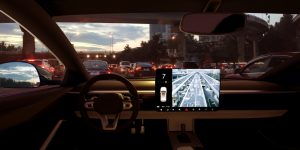 By David M. Feehan
By David M. Feehan
It came much faster than I anticipated–the future, I mean. Two events told me that the future of mobility is closer than I realized, because my wife and I experienced it.
My wife works for a federal agency here in the Washington, D.C., area. A couple of weeks ago, her staff had an off-site meeting and one of her colleagues offered to drive. As they were standing near the surface parking lot adjacent to the building, her colleague summoned his Tesla from the lot, and driverless, it emerged alongside the curb to pick them up. She was, quite frankly, stunned.
Then last week, while doing some consulting work in the Twin Cities, I received a call from my brother. His son just acquired a new Tesla. Would I like to try driving it? Of course, I jumped at the chance.
Along with two of my nephews, Sean, the owner of the Tesla, gave us a brief orientation to the controls and off we went. “My Lord,” I thought, “This feels like it’s rocket propelled.” I’ve driven fast cars before, but this was unlike anything I had ever driven. Then the real “future” experience hit me. I shifted into self-driving mode, and we were navigating down a dark country road with me in the driver’s seat, and with my hands and feet off the controls. The car was literally driving itself.
You can read all you want about autonomous vehicles, but until you’ve actually driven one, especially at night on a winding road with no streetlights, you simply cannot fully imagine this experience.
I have written articles about AVs and when we can expect to be driving them. I have suggested that fully autonomous vehicles could be decades away. I was wrong. Tesla will be selling them within a year. You can buy a Tesla that is about 90 percent self-driving right now.
At first, it’s scary. But I quickly got used to it and I could imagine all of the ways this incredible device could make my travel easier. Suddenly, traffic-clogged commutes wouldn’t be so bad. I would read the morning news and emails on my iPad, or catch a few extra Zs. On a long road trip, I could relax and just enjoy the scenery or engage in conversation with my traveling companions. I wouldn’t have to worry about getting a speeding ticket. The car would automatically obey the speed limit. When I arrived at my destination, the car would find a parking spot and park itself.
The future is here, or almost. And I think I like it.
David M. Feehan is president of Civitas Consultants, LLC.
 By some estimates, we should have been relaxing in our autonomous cars by now. But that dream keeps getting pushed back, and Fast Company says they know why: Basic human nature.
By some estimates, we should have been relaxing in our autonomous cars by now. But that dream keeps getting pushed back, and Fast Company says they know why: Basic human nature.
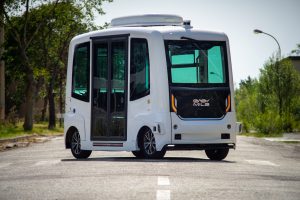 Twelve-passenger, driverless buses will hit real roads in Gainesville, Fla., later this year, marking the first time autonomous shuttles travel among other traffic in the U.S.
Twelve-passenger, driverless buses will hit real roads in Gainesville, Fla., later this year, marking the first time autonomous shuttles travel among other traffic in the U.S. Fleets of self-driving vehicles are about to become the norm. What does that mean for the parking and mobility industry? We’ll give you a hint: They’re driverless. Autonomous vehicles will change the fundamentals of the entire transportation landscape, and that includes fleets–and the way they interact with parking and mobility facilities and infrastructure.
Fleets of self-driving vehicles are about to become the norm. What does that mean for the parking and mobility industry? We’ll give you a hint: They’re driverless. Autonomous vehicles will change the fundamentals of the entire transportation landscape, and that includes fleets–and the way they interact with parking and mobility facilities and infrastructure. By David M. Feehan
By David M. Feehan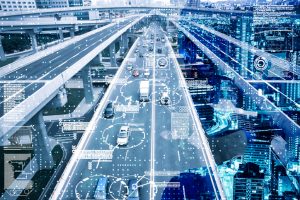 Signs that change messages as curb demand flexes, autonomous school buses that also deliver packages, car-free downtown cores, and friendly delivery robots are among the revelations a prominent futurist predicts for urban mobility in the not-too-distant future.
Signs that change messages as curb demand flexes, autonomous school buses that also deliver packages, car-free downtown cores, and friendly delivery robots are among the revelations a prominent futurist predicts for urban mobility in the not-too-distant future.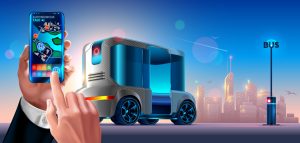 Driverless shuttles are on the road in Reston, Va., a suburb of Washington, D.C., and while things are going pretty well so far, the pilot has also highlighted why driverless cars may still be some time away.
Driverless shuttles are on the road in Reston, Va., a suburb of Washington, D.C., and while things are going pretty well so far, the pilot has also highlighted why driverless cars may still be some time away. We’ve all heard about the LIDAR and sensor and road-following technology in development so cars can learn to drive themselves. As it turns out, that might include new lane-marking tape, and a Canadian company is already on top of it.
We’ve all heard about the LIDAR and sensor and road-following technology in development so cars can learn to drive themselves. As it turns out, that might include new lane-marking tape, and a Canadian company is already on top of it.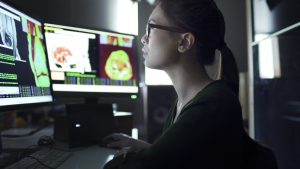
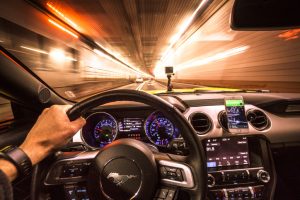 In what many believe is a step toward a greater role in mobility, automaker Ford this week acquired Journey Holding Corporation, which develops intelligent transportation software, and Quantum Signal AI, which develops robotics–notably a testing simulator for artificial intelligence (AI) systems; it develops systems for the U.S. military. Ford said the buys will help advance its Transportation as a Service (TaaS) platform.
In what many believe is a step toward a greater role in mobility, automaker Ford this week acquired Journey Holding Corporation, which develops intelligent transportation software, and Quantum Signal AI, which develops robotics–notably a testing simulator for artificial intelligence (AI) systems; it develops systems for the U.S. military. Ford said the buys will help advance its Transportation as a Service (TaaS) platform.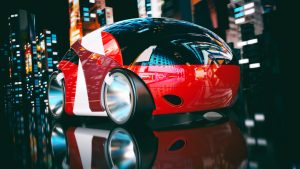 Autonomous vehicles (AVs) will reduce the demand for parking in cities. Or they might increase it, depending. Same for the need for driving lanes, which affect the availability of bike lanes and pedestrian pathways. They might make cities more–or less–walkable, too.
Autonomous vehicles (AVs) will reduce the demand for parking in cities. Or they might increase it, depending. Same for the need for driving lanes, which affect the availability of bike lanes and pedestrian pathways. They might make cities more–or less–walkable, too.